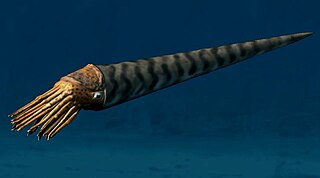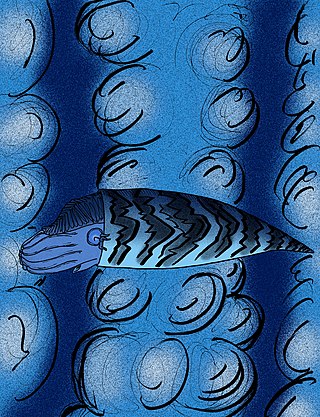
Orthoceras is a genus of extinct nautiloid cephalopod restricted to Middle Ordovician-aged marine limestones of the Baltic States and Sweden. This genus is sometimes called Orthoceratites. Note it is sometimes misspelled as Orthocera, Orthocerus or Orthoceros.
Rayonnoceras is a genus of extinct cephalopods that lived around 325 million years ago during the Carboniferous. Although they resemble earlier actinocerids they are now though to belong to the Pseudorthocerida

Endocerida is an extinct nautiloid order, a group of cephalopods from the Lower Paleozoic with cone-like deposits in their siphuncle. Endocerida was a diverse group of cephalopods that lived from the Early Ordovician possibly to the Late Silurian. Their shells were variable in form. Some were straight (orthoconic), others curved (cyrtoconic); some were long (longiconic), others short (breviconic). Some long-shelled forms like Endoceras attained shell lengths close to 6 metres (20 ft). The related Cameroceras is anecdotally reported to have reached lengths approaching 9 metres (30 ft), but these claims are problematic. The overwhelming majority of endocerids and nautiloids in general are much smaller, usually less than a meter long when fully grown.

The Bactritida are a small order of more or less straight-shelled (orthoconic) cephalopods that first appeared during the Emsian stage of the Devonian period with questionable origins in Pragian stage before 409 million years ago, and persisted until Carnian pluvial event in the upper middle Carnian stage of the Triassic period. They are considered ancestors of the ammonoids, as well as of the coleoids.

Endoceras is an extinct genus of large, straight shelled cephalopods that gives its name to the Nautiloid order Endocerida. The genus lived during the middle and upper Ordovician 485 to 419 million years ago. The cross section in the mature portion is slightly wider than high, but is narrower laterally in the young. Sutures are straight and transverse. Endoceras has a large siphuncle, located close to the ventral margin, composed of concave segments, especially in the young but which may be tubular in the adult stage. Endocones are simple, subcircular in cross section, and penetrated by a narrow tube which may contain diaphragms reminiscent of the Ellesmerocerid ancestor.
Suecoceras is an endoceratid that lived during the Middle Ordovician. It is characterised by a long, straight, slender shell with a slightly expanded tip that curves slightly downwards.

Nanno is an extinct genus of endocerid, named by Clarke in 1894 for the apical end of an endocerid from the Trenton Limestone of New York state that has the basic description of the nanno type. It is possibly a senior synonym for Proterovaginoceras. As a valid genus, Nanno is included in the Endoceratidae, but the nanno type apex may be found in other families.
Actinoceras is the principal and root genus of the Actinoceratidae, a major family in the Actinocerida, that lived during the Middle and Late Ordovician. It is an extinct genus of nautiloid cephalopod that thrived in the warm waters of the United States and England during the Paleozoic era.
Spyroceras is a genus of pseudorthocerids from the Devonian of North America and Europe, defined by Alpheus Hyatt in 1884. Pseudorthocerids are a kind of orthocertaoid, a taxonomic group within the Nautiloidea. Specifically Spyroceras belongs to the pseudorthocerid family, Spyroceratidae.
Homaloceras is an extinct nautiloid cephalopod from the Middle Devonian with a strongly curved shell, included in the nautilid family Centroceratidae.
Baltoceratidae is an extinct family of orthoconic cephalopods belonging to the subclass Nautiloidea endemic to what would be Asia, Australia, Europe, North America, and South America during the Ordovician living from about 480–460 mya, existing for approximately 20 million years.
Carbactinoceratidae is a family of extinct cephalopods with external shells that lived around 325 million years ago, during the Carboniferous period. They were the last group of orthocones to attain sizes exceeding one meter in length. One specimen of the carbactinoceratid species Rayonnoceras solidiforme, recently found in Arkansas, was measured at 2.5 metres (8.2 ft) long.

The Lituitidae are a family of evolved tarphycerids characterized by a long orthoconic section that follows a coiled juvenile portion at the apex, along with a generally tubular siphuncle, which like that of the barrandeocerids is composed of thin connecting rings.

Endoceratidae is a family of large to very large straight shelled nautiloid cephalopods belonging to the order Endocerida that lived during the Middle and Late Ordovician. They include the largest known Paleozoic invertebrates, represented by Endoceras and Cameroceras.
Chazyoceras is a moderately large endocerid included in the Endoceratidae with a Nanno type apex and a ventral siphuncle with a holochoanitic wall, characteristic of the family. The siphuncle swelling at the apex is subtriangular in longitudinal profile. The endocones are of medium length.
Triendoceras is a genus of fairly large endocerid named by Flower (1958), included in the Endoceratidae by Teichert (1964), characterized by a holochoanitic ventral siphuncle in which the cross section through the endocones has an opening in the shape of an isosceles triangle with a sharp apex (corner) pointing down. Triendoceras is found in the upper Lower Ordovician of Quebec and New York in North America and possibly in Ohio, and in eastern Europe. The type species is T. montrealense.
Kobyashiceras is an extinct genus in the cephalopod order Actinocerida, from Lower Devonian marine sediments in Japan. The type and sole included species is Kobayashiceras gifuense. The generic name honors the late Dr. Teiichi Kobayashi who contributed greatly to the study of Paleozoic cephalopods. The specific name is derived from Gifu, the name of the prefecture in which the type locality is found.
Plectoceras is a genus of nautiloids included in the tarphycerid suborder Barrandeocerina that lived during the Middle and Late Ordovician. It has been found widespread in the Middle and Upper Ordovician of North America.
Cyrtogomphoceras is a genus of nautiloid cephalopods, recognized by its large breviconic shell with a notable endogastric curvature. The shell is fusiform in profile, reaching maximum width at or near the base of body chamber, which narrows toward the aperture. The siphuncle is large and slightly removed from the ventral side, that with the concave longitudinal profile. Siphuncle segments are short, as are chambers; septal necks recurved, connecting rings thick, bullettes at the apical end of the rings swollen. Cameral deposits are lacking.
Discosoridae comprise a family of endogastric discosorids,, with endocones in the siphuncle, ranging from the Middle Silurian to Middle Devonian.






